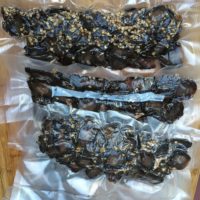Keys to storing biltong so it is fresh and safe to eat:
-
Keep it dry
-
Keep it in a fridge
-
Vacuum seal it
-
Keep pieces apart or mix them up daily
Quality biltong is highly dependent on using the correct methods to make and store it. If you like your biltong slightly wet i.e. not dry all the way through, then this is even more important since the higher the moisture in food the more chance it can get moldy. I do not advocate using preservatives as I like biltong to be as natural as possible and therefore proper storage is even more important. Storing biltong properly will ensure it keeps it’s taste and is safe to eat.
An important factor that impacts how storing biltong is where you live geographically – and even the time of the year. If you are in a very dry environment such as the USA West or South West (e.g. Texas, Arizona, California, New Mexico etc.) or the Kalahari or Karoo in South Africa, then there is less chance for food to get mold. However, if you live in an area with high humidity or a rainy environment such the USA North West (Washington, Oregon), USA North East, the UK (pretty much anywhere!) or coastal areas with high heat and humidity such as Durban in South Africa or Florida in the USA, then proper storage is crucial.
Hot and humid summer months also pose a greater risk for mold to develop. Traditionally winter was the biltong making season (before the advent of biltong boxes and dehydrator, biltong was hung outdoors or in the rafters). A cool air-conditioned room, or dry cool basement, will also help provide the right environment for making and storing biltong.
In general, biltong should last for at least 4-6 days before being at risk of developing mold. The best methods to extend that time are to vacuum seal it or keep in a fridge. In a well ventilated, non-humid environment biltong sticks / pieces can last for weeks or even months.
For food to go moldy (even in humid climates) it needs to be exposed to oxygen. Therefore it is recommended that you keep your biltong sealed until you want to eat it. When removing biltong slices from a vacuum-sealed package, mix the slices in an open container or plate. If your biltong is sliced, mixing it up daily will help keep pieces drier for slightly longer. This is also true when you are drying in a biltong box – i.e. be very careful to avoid pieces touching each other.
Key takeaways: Biltong’s enemies are MOISTURE, HEAT and OXYGEN!
Biltong can also be kept for slightly longer periods in the fridge. You can even freeze biltong – although I don’t recommend as it may change the texture of biltong. If you do remove biltong from a fridge or (especially) a freezer, place it immediately in a well ventilated and dry area as it will release moisture as it warms up or defrosts. You can also use a paper kitchen towel to pat down and remove any moisture that gathers on the biltong. Never keep biltong in a (non-vacuum) sealed container as the meat will sweat which leads to mold. Likewise, never store or transport biltong in a plastic bag – rather use a paper bag that will help keep it dry.
Dry “sticks” or “stokkies” of biltong will keep longer as they have less moisture than slices or thick pieces. If sticks are stored together then mix them up occasionally so that the touching surfaces of the meat are regularly changed. Storing biltong that is drier is easier than wet biltong.
A good quality food vacuum sealer can be purchased for around $60 (or even less). It takes a few minutes to slice the biltong and seal it up. Try crushing some fresh coriander seeds and sprinkle them in with the slices before you seal the packets (see the pictures below). This gives the biltong a really nice fresh taste when it is unsealed.








